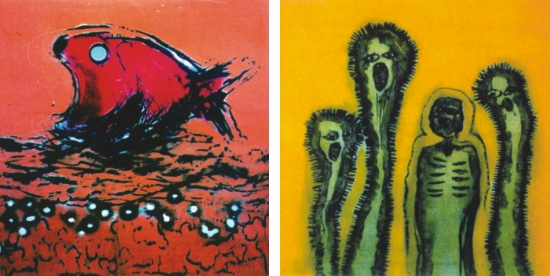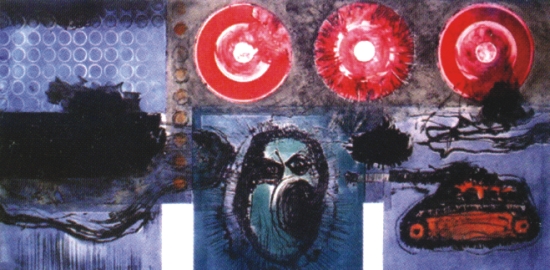|
Art
 When the World Falls Apart When the World Falls Apart
Mustafa Zaman
The recent solo exhibition by A Rahman is an ode to the world gone awry. Through a series called "Lethal Chamber", the artist vents his disillusionment over the present world order. But he is not overtly political, what he brings to the fore is a sense of uneasiness through his expressionistic rendition of strange faces, marginalised humans, and alien looking vermin. In one particular work three parasites rear their heads while a lonely figure of a man shivers in fear. The parasites open their mouths as if to express the animosity towards the man. The artist says that all over the world humans are being subjected to inhuman treatment. "It is not only in Iraq that the innocents are falling victim to the excesses of the people at the helm. The same thing has happened in Bosnia, Algeria and is happening in Bangladesh, India and many other countries that are outwardly democratic," says the artist. It is the tyranny of men against men that is the source of Rahman's fear, and his art is fraught with such trepidation.
Rahman has been known for his nature-derived imagery. It is in the recent solo that he emerged as an artist bent on addressing the human condition in a world teetering to the brink of destruction. Rahman's recent show that ran in the Gallery Chitrak from April to 16 was aptly titled "Broken World", and it brought out in the open a flurry of unsavoury images which is deeply rooted in our skepticism regarding a world where logic and rules sometimes become the means to subjugate an otherwise powerless majority. However, the way the artist ponders such depredation has a poetic side to it. Rahman expresses the anguish and fear that results from all that goes on in the world, which he sees as a torture chamber without compromising his attachment to aesthetic claim. His language is metaphoric. As such his art avoids delineation of all that is wrong about the world. It is the transgression of the seamy side of reality on the personal domain that the artist brings to light. Though his expression is harsh, there is a certain kind of visual harmony that he strives to achieve in each of his works; and this makes his images tolerable to the eyes.

Only in one picture the artist's references to the war-torn world takes on a realistic turn. He brought in an image of a tank right next to a deformed screaming head. In other works the artists resorts to symbolism. An all-devouring big fish, a mangled head, or a couple of human figures with heads of animals, or an obscure animal form, these are the motifs with which Rahman expresses his fear of persecution and mistrust in the current world order. These are the very motifs that put him in a joust with the likes of Edvard Munch and Emile Nolde, the two European expressionists who pioneered in bringing the tortured human soul out in the open. The challenge facing this thirty-plus artist is to supersede such modernists who appealed mostly to the primal emotion of fear.  Faced with the question whether his attempts at exposing human vulnerability is a premeditated one, Rahman declares that the process was a spontaneous one. He claims that his transformation from the artist who mostly drew on nature to the one who now addresses the human condition amidst a world dominated by ogres was not a forced one. "I just decided not to cater to the group of people that we refer to as the aristocratic class. I do not belong to that class and I believe my recent works are done keeping this fact in mind," says Rahman. The artist who mostly doted on the abstract expressionist art of the country is now all bucked up to lay claim to the world of new figuration, a kind of imagery that strives to re-examine the place of the humans in a turbulent world. Faced with the question whether his attempts at exposing human vulnerability is a premeditated one, Rahman declares that the process was a spontaneous one. He claims that his transformation from the artist who mostly drew on nature to the one who now addresses the human condition amidst a world dominated by ogres was not a forced one. "I just decided not to cater to the group of people that we refer to as the aristocratic class. I do not belong to that class and I believe my recent works are done keeping this fact in mind," says Rahman. The artist who mostly doted on the abstract expressionist art of the country is now all bucked up to lay claim to the world of new figuration, a kind of imagery that strives to re-examine the place of the humans in a turbulent world.
Rahman has been living in Rome for the last three years. As a Bangldeshi living in Italy he has been assailed by the overwhelming feeling of nationalism. In his recent exhibition, through a number of works, he comes to term with this emotion. The pervasive presence of green and that symbolic red circle are the two points of reference that remind one of the national flag. In a number of pieces the direct affinity with the motherland is expressed in an offhand manner. In fact it is this offhand attitude that brings a sense of immediacy to his imagery and it makes Rahman's recent yield extremely interesting.
It is noteworthy that all of the works Rahman did were prints taken from either plastic-wood plates or improvised surfaces used as plates. His ingenuity lies in the fact that he has been consistent as a printmaker with a knack for resonant imagery.

Copyright (R) thedailystar.net 2006
|
